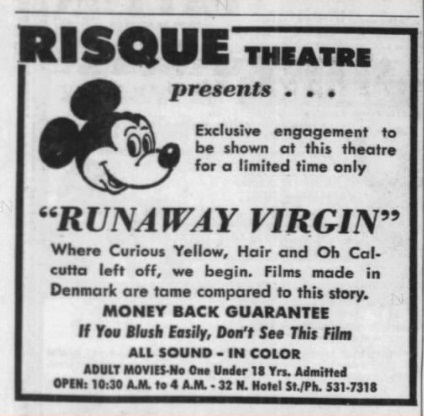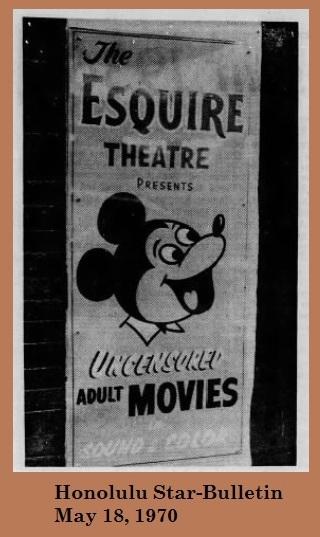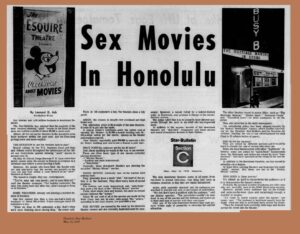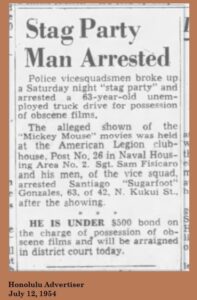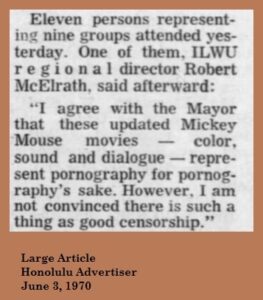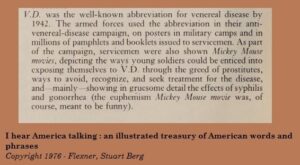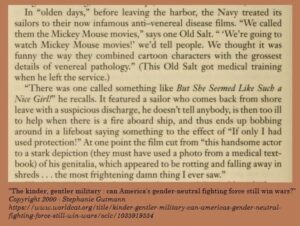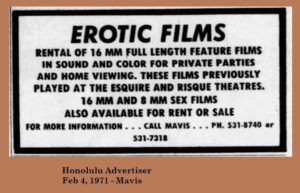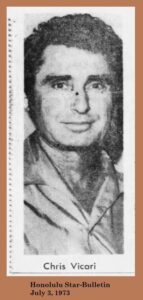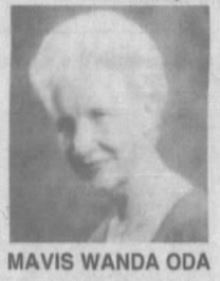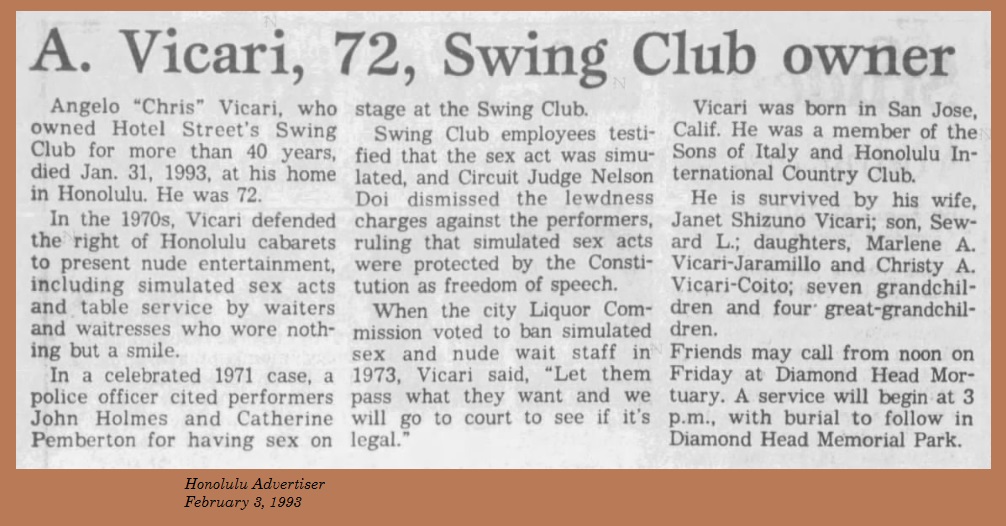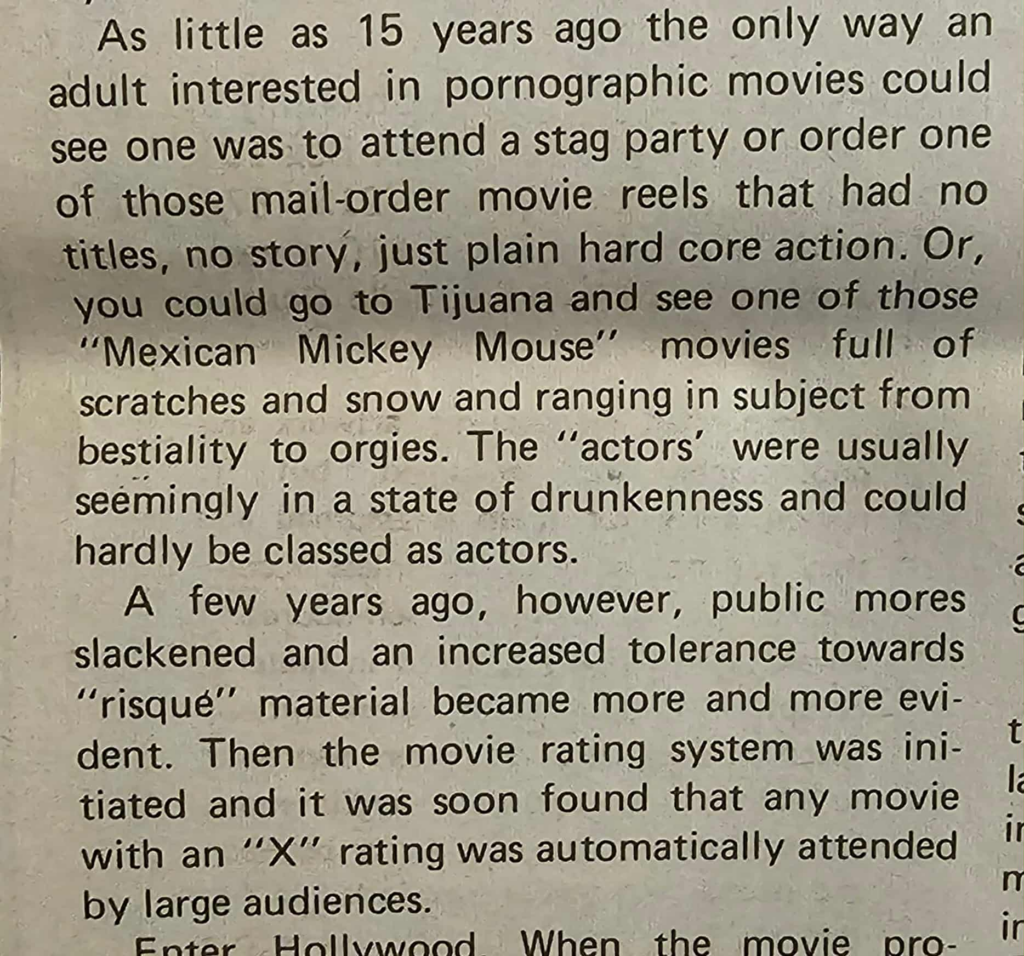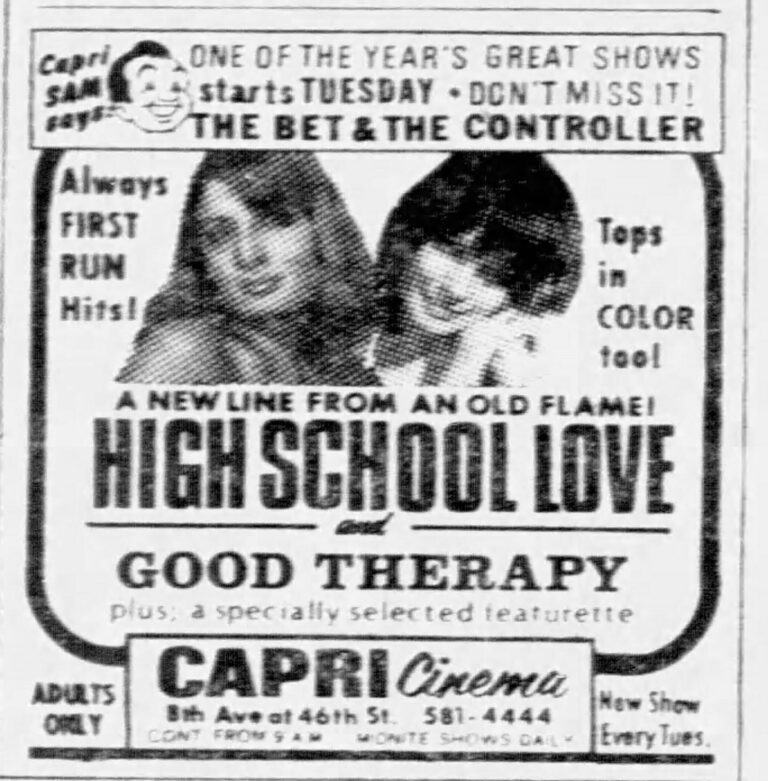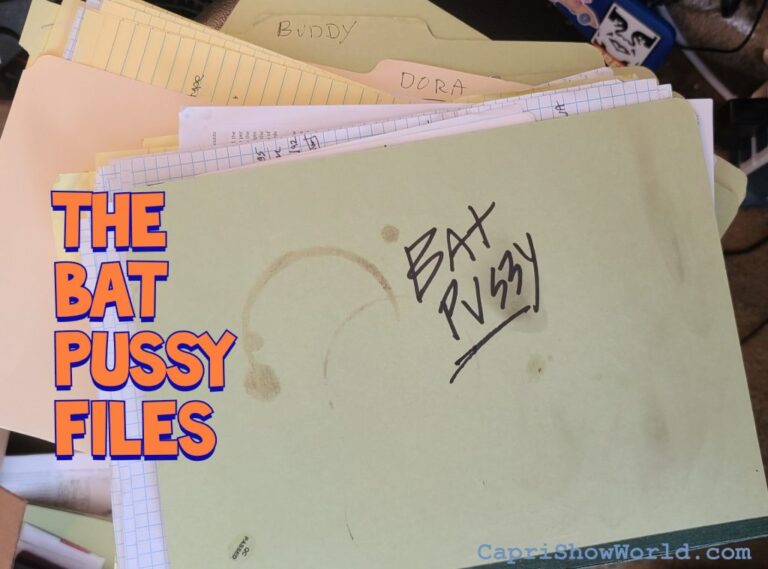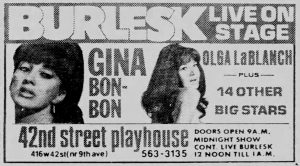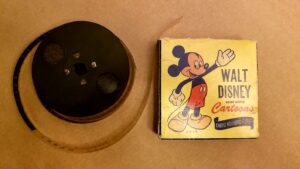
Remember that time back in the early 1970’s that Mickey Mouse got pissed off with Disney and briefly took a job in Hawaii hocking porno films? No? Well read on…
Last weekend [1] while researching an early OSCO/ZIEHM effort, THE VIRGIN RUNAWAY/RUNAWAY VIRGIN, I came across what I thought was just another amusing ploy that a theater in Honolulu used back in 1970 to catch the punter’s eye. Right there in an ad for THE RUNAWAY VIRGIN at the Risqué Theater was none other than Mickey Mouse himself!
“Well THAT’s odd”, I thought, and moved on…but that nagging feeling that there could be more to this had reared its head and stuck with me as I moved on.
Much later, while still sifting through old ads, again in a Honolulu paper, I yet again ran into Mickey Mouse being used to advertise an adult move, but this wasn’t a clip-art cut-out in a print ad, this time it was actually a picture of the theater itself with what I’m 100% positive was intended to be Mickey’s face on the sign outside.
“OK, this has to mean something”, said that nagging feeling, which had now upgraded itself to voice-in-my-head status. Perhaps it meant that in addition to the expected adult fare, the theater also had a kid’s slate of films (don’t laugh, there was actually a theater in Tallahassee, Randy’s Campus Art, that tried to play kid’s flicks in the morning and adult porno’s at night…that scheme didn’t last). But I could not find anything to back this theory up for the two theaters in Honolulu.
So I thought I’d try to determine how long Mickey had been used by these theaters, and based on the two Honolulu papers I have access to it appears that it started on May 1, 1970, but by May 9 the Mickey face had been whited-out (perhaps the folks at Disney got wind of it…).
So, one week (and I just “happened” to find one of those 8 days to trigger this saga).
So, was that it? A one-time gimmick used by a couple of theaters on Hotel Street back in 1970? Maybe, but that nagging voice didn’t think so (it was getting to be annoying by this point), and so on I trudged…
And there it was, the first “evidence” that there was something more, right in the article with the theater picture (it pays to read the whole article BEFORE moving on):
‘What does a customer get for his $5 ticket?
Just about anything he wants in the way of sex movies.
There are three basic type of sex movies currently playing downtown:-“Mickey Mouse.”
-Lesbian and male homosexual.
-“Skin-flicks”Currently, three downtown theaters are showing the so-called “Mickey Mouse” movies.
These movies, relatively new on the market, hold nothing back.
They generally have a weak “plot”, but most of the action is in the bedroom. They show every form of carnal relations.
The lesbian and male homosexual and “skin-flicks” stop quite a bit short of the “Mickey Mouse” movies.
These show naked men and women, but show no sexual contact between the “actors”.’– Honolulu Star-Bulletin – May 18, 1970
OK, so that clears everything it up…well, no, not at all. (that nagging guy in my head typed that, not me…)
Digging deeper we find the term “Mickey Mouse Movie” used a few times in newspapers, all from Hawaii, and the earliest from a 1954 article:
‘Police vicesquadsmen broke up a Saturday night “stag party” and arrest a 63-year-old unemployed truck drive(sic) for possession of obscene films. The alleged shown(sic) of “Mickey Mouse” movies was held at the American Legion clubhouse, Post no. 26 in Naval Housing Area no. 2’
– Honolulu Advertiser – July 12, 1954
Another example, more contemporary to the 1970s, comes from a review of the film I AM CURIOUS (YELLOW):
‘Vilgot Sjoman’s film about sexual and political hang-ups in Sweden is, at best, explicit and frank in treatment of nudity and the sex act: a milestone of a flick, with supposedly the first exposure of male and female genitalia in a non-Mickey Mouse movie’
– Honolulu Advertiser – August 25, 1969
And two more from 1970:
(from an article about a local anti-smut group meeting) –
‘Eleven person representing nine groups attended yesterday. One of them, ILWU regional director Robert McElrath, said afterward” “I agree with the Mayor that these updated Mickey Mouse movies – color, sound and dialogue – represent pornography for pornography’s sake. However, I am not convinced there is such a thing as good censorship.’
Honolulu Advertiser – June 3, 1970
And another anti-smut meeting review –
‘The ones that are damaging are the “Mickey Mouse” films being shown on Hotel Street in Honolulu” (State Representative William) Fernandez said. “This is what we want to prevent from coming here.”
Honolulu Advertiser – July 2, 1970
So we have four newspaper references, all from Hawaii. I also did a broader search, but the only viable results were still from Hawaii. Did this mean that the “Mickey Mouse Movie” term was a Hawaiian thing? Could it be linked to the significant Asian influence in the Islands? I couldn’t find anything else to back these theories up (I would NOT recommend Googling “Asian” “Mickey Mouse Movie” “Pornography”—unless you’re in to that stuff, and if you found this because you are actually in to that stuff then the rest of this post if going to be pretty deflating for you…).
So, it was now on to other areas of the cyber-rabbit-warren.
Moving away from newspapers and looking towards reference materials we actually start getting some clarity on the background of the term.
First from “A Concise Dictionary of Slang and Unconventional English” (1990 – Eric Partridge):
‘Mickey Mouse Movies – Films so called, “because they show lots of pubic hair but little else, the trade [in “exploitation-of-sex”] contemptuously dubs [them thus]”.
And second from “The New Partridge Dictionary of Slang and Unconventional English (2006, Partridge):
‘Mickey Mouse Movie noun
A pornographic film that shows little or no detailed activity’
Bad writing in the first item aside, this does confirm that Mickey Mouse Movies are in fact sex films, and it does show where the line was drawn, or more importantly that there still was a line: which meant that the films these two references were describing were NOT (yet) hard-core. But there was that nagging voice once again casting doubt, reminding me of a few important points from that earlier article. So we’ll revisit the question of how explicit these particular Mickey Mouse films in our scope were again in a few stanzas.
While we’ve got verification that there is/was a term “Mickey Mouse Movies” and it was in some way used to describe sex films, this still doesn’t give us any clues as to ‘why’ these films were called “Mickey Mouse Movies”.
I continued to dig (that nagging SOB voice in my head wouldn’t let me stop now), and finally found the answer, in of all places, The United States Armed Services:
‘As part of the (the armed forces anti-venereal-disease) campaign servicemen were also shown Mickey Mouse movies, depicting the ways young soldiers could be enticed into exposing themselves to V.D. through the greed of prostitutes, ways to avoid, recognize, and seek treatment for the disease, and – mainly – showing in gruesome detail the effects of syphilis and gonorrhea (the euphemism Mickey Mouse movie was, of course, meant to be funny).’
I Hear America Talking: An Illustrated Treasury of American Words and Phrases – Stuart Berg Flexner – 1976
–
This was confirmed by in “The Kinder, Gentler Military: Can America’s Gender-neutral Fighting Force Still Win Wars?”:
‘In “olden days”, before leaving the harbor, the Navy treated its sailors to their now infamous anti-venereal disease films. “We called them Mickey Mouse movies,” says one Old Salt. “‘We’re going to watch Mickey Mouse movies!” we’d tell people. We thought it was funny the way they combined cartoon characters with the grossest details of venereal pathology.” – see side-bar for a description
The Kinder, Gentler Military: Can America’s Gender-neutral Fighting Force Still Win Wars?” (2000 – Stephanie Gutmann)
These should not of course be confused with the “official” VD film Disney made in 1973:
So the usage of “Mickey Mouse movie” seems to have started as a joke name for the VD educational films made for the US Military. And while Disney did make a ton of films for the military during WWII I haven’t found any VD or “safe-sex” films from Disney for the military, yet (the above Disney VD film was not made for the military).
Then, as people left the Service, they continued to use the term “Mickey Mouse” to describe stag films, or perhaps just the white-coaters, so-called because they used the premise of an (sex) educational film to show naughty (aka illegal-ish) stuff. That seemed to wrap this saga up…except that didn’t fully align with what we saw in that article at the beginning of this (I beat that voice to it this time). So, I think the meaning continued to evolve with the loosening of what was allowed to be shown, up to, and probably even beyond the holy-of-holies itself (aka penetration).
So my working theory is that while “Mickey Mouse movies” did start out life as true educational films, and then evolved to mean soft-core stag films and/or white-coaters, by the time 1970 came round the folks on Hotel Street in Honolulu had pushed the meaning to be used to “secretly” denote that the full-length feature films (as opposed to stag reels or loops) being flashed on their screens had in fact crossed that line of penetration and they were, in full color and sound, full-blown hardcore.
Consider the following:
- The film being advertised, “RUNAWAY VIRGIN”, was in fact a feature-length hardcore film, which predated the more popularly recognized MONA (remember this was what I was originally supposed to be researching).
- The main article referenced above clearly says “These movies, relatively new on the market, hold nothing back”, as well as “They show every form of carnal relations”. Now it’s one thing for a theater ad to say that, but I would think it’s quite another for a newspaper to suggest that.
- The Mickey Mouse icon was used for only one week, and primarily to advertise RUNAWAY VIRGIN (hardcore), and briefly to advertise two films that I cannot find a single shred of information on, MERRY BACHELOR and SUMPIN DIFFERENT, however the ad does indicate that in the former “Nothing has been left out” and that the latter “leaves nothing to the imagination”. Again since this is an adult theater ad, and we don’t have the films available to verify, we should take this with a grain of salt, but I’d still bet a good lunch that they had at the very least hardcore inserts.
- Chris Vicari (see Bonus Section), who was the owner/manager/some-how-invovled with both theaters, was former military, and thus probably would have been subjected to the “original” “Mickey Mouse movies”. He was also known for pushing the bounds of what was considered acceptable entertainment (see obituary in Bonus Section). So I’m betting when he advertised that the film being shown would “hold nothing back” there’s a good chance it meant hardcore.
To be clear what I’m suggesting: Mickey Mouse Movies, or an ad/sign with Mickey’s face on it, was code for hardcore feature films. Well, at least for one week, on one street, in Honolulu, in 1970.
On a scale of 1 to 10 I’d say my level of confidence in this theory is about a 9. And for what it’s worth, that voice in my head agrees (although he suggests we might go up 9.95).
So there you have it, the story of that one week that Mickey Mouse was a Hawaiian porn peddler. You’re Welcome.
But Wait, There’s More – Bonus Section
I got a little curious about the two theaters that were blatantly using Uncle Walt’s Most Cherished to send underground messages about crossing the penetration Rubicon. It just so happened that i had just read the section of Bob Chinn’s autobiography, “The Other Side of Paradise – The Uncensored Memoirs of Bob Chinn – Vols 1 and 2” in which he details the filming of PRISONER OF PARADISE (1980), and realized he’d mentioned those very theaters! Before we get to that, fliping back several pages I remembered he also mentioned them earlier in the book when he was recalling the first trip to Hawaii with John Holmes to film TROPIC OF PASSION (1973):
“Honolulu had always been one of our major film markets. Our films played a the Risque and Esquire Theaters, wich were owned by Chris Vicari who also owned the notorious bar called the Swing Club right down the street. A shrewd businesswoman with platinum blonde hair and one glass eye named Mavis Oda managed and booked the theaters. We made arrangements with them to use their theater as a location where we filed one of their dancers, Cassandra, doing her act.”
Then in 1980 Chinn returned to Hotel Street:
“Later, we made a trip to downtown Honolulu where John (Holmes) and I returned to Hotel Street and visited our old friend Mavis Oda at the Esquire and Risque Theaters and paid our respects to Chris Vicari at the Swing Club on Hotel Street. Mavis and Chris were friendly, sociable, and brimming with Aloha even though the new films that I was making for other producers were no longer playing their small mini-theaters but instead were now booked into Narcisco Yu’s family-owned Yuclan chain of regular movie theaters.” – page 218
And it seems that while he was there Chinn was overtaken by the spirit that inhabits at least one of our other blogs (PlacesGoneBy[e]):
“While I was showing John and the others around my old haunts in the Chinatown area, I came up with the germ of an idea for another Wadd film. Just seeing the whole area once again was such an inspiration to me that i almost couldn’t believe it. It still looked almost the same way I had remembered it from my childhood back in the early 1950s.
Those old, rickety wooden two-story buildings and tenements that still remained from the turn of the century and rebuilt during the late teens and early 1920s were still there, but I knew that they wouldn’t be there for much longer. The days were numbered for Hotel Street, once a place soldiers and sailors had flocked to looking for fun and thrills. With urban renewal (what we now call gentrification) well on its way, the whole character of the place was about to change.
I wanted, more than anything, to be able to capture this little bit of history on film before the buildings were all torn down…
…We managed to shoot some terrific location footage in just about all of the downtown districts where there were colorful old, time-worn buildings, including Nuuana and Kalihi. I felt somewhat comforted at having recorded for posterity many of the ancient bars, shops , and places of business that are sadly no longer there.” page 342
The Other Side of Paradise – The Uncensored Memoirs of Bob Chinn
Unfortunately John Holmes’s drug use and ultimate downfall precluded this “last” Wadd film from being finished, and Chinn noted “that I had never been able to finish this film is one of the greatest disappointments that I ever encountered as a filmmaker.”
Angelo “Chris” Vicari passed away in 1993 at the age of 72 in Honolulu. See his obituary from the Honolulu Advertiser (at the end of this article), the same paper in which we first encountered Mickey Mouse in his ad.
Mavis also continued in the Hotel Street theater business until her death in 2002 , although in 1994 it appears she moved operations outside of downtown once Hotel Street had started its long road to gentrification, which also took both the Risque and Esquire Theaters around the 1993/94 time frame as well.
UPDATE 1 – December 2023
I reached out to Bob Chinn himself and showed him an earlier version of this post. I asked him if he remembered every hearing Mickey Mouse used in relation to smut films. His response follows:
“Yes, I had heard of this serviceman’s usage of “Mickey Mouse films” as applied to clandestine stag film showings. But in regard to newspaper listings of sex films as far as I know it was purely a Hawaii thing, probably, as you surmised, resulting from Chris Vicari’s military service.”
There’s a lot more to be told about the adult theaters and the people who ran, worked, and frequented them, but that’s for another time…
UPDATE 2 – September 2025
While researching something completely different I came across another Mickey Mouse Movie reference, this time in a 1972 Los Angeles swinger rag called Swing. This time it points us south of the border to Tijuana, to a bread of stags evidently known as Mexican Mickey Mouse films! As described here, “movies full of scratches and snow and ranging in subject from bestiality to orgies. The ‘actors’ were usually seemingly in a state of drunkenness and could hardly be classed as actors.” Aside from the animal part they just described about half the hardcore films made between 1969 and 1974!
Notes and things...- This was originally written in 2019[↑]

